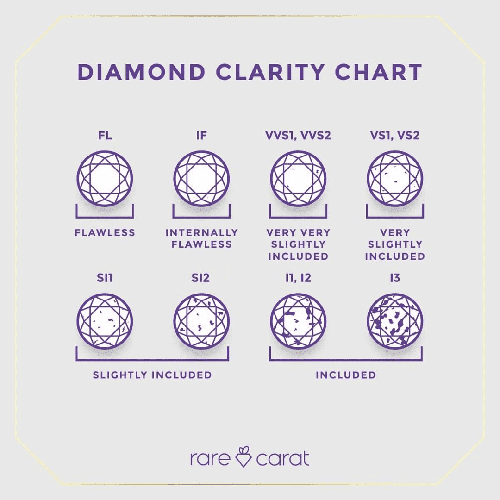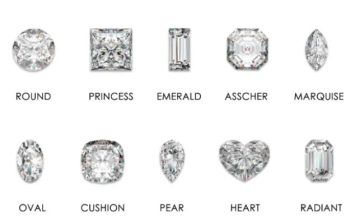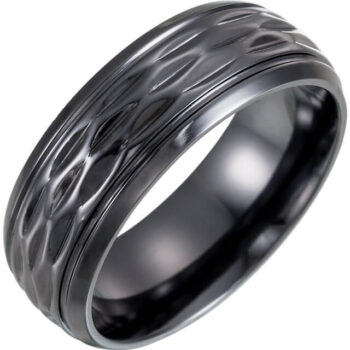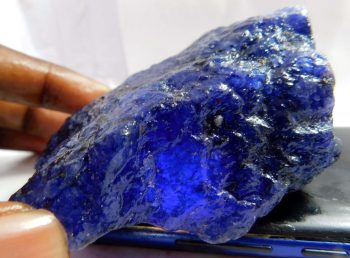What Is A VVS Diamond is a common question part of a larger one about diamond clarity. What is it? Why is diamond clarity so important? How do clarity grades affect price? We will discuss all of this and more in this post.
What Is A VVS Diamond?
A VVS diamond is a type of diamond that is known for its exceptional clarity. The term VVS stands for “Very Very Slightly Included,” which means that these diamonds have very few, if any, internal or external flaws. This high level of clarity makes VVS diamonds highly sought after and prized in the jewelry industry.
VVS diamonds are graded on a scale that ranges from VVS1 to VVS2, with VVS1 being the highest grade. These diamonds have microscopic inclusions that are extremely difficult to see even under 10x magnification. In fact, it often takes a trained gemologist to identify these inclusions.
The exceptional clarity of VVS diamonds allows them to reflect light beautifully, creating a stunning sparkle and brilliance. This is why VVS diamonds are often used in engagement rings and other high-end jewelry pieces. However, it’s important to note that the clarity of a diamond is just one of the factors that determine its overall value. Cut, color, and carat weight are also important considerations when evaluating a diamond’s worth.
The bottom line is that a VVS diamond is a diamond with very few internal or external flaws, making it highly valued for its exceptional clarity. These diamonds are graded on a scale and are known for their stunning sparkle and brilliance. Whether you’re in the market for an engagement ring or simply appreciate the beauty of diamonds, a VVS diamond is a top choice for those seeking a truly exquisite gemstone.
The GIA Clarity Grading System
The GIA Clarity Grading System is a standardized method used to assess the clarity of diamonds and other gemstones. It is important to understand this system because it provides valuable information about the presence of any internal or external flaws, known as inclusions and blemishes, respectively. The system consists of six categories, ranging from Flawless to Included, with further subdivisions within each category. This system allows consumers and professionals to accurately describe and compare the clarity of diamonds, helping them make informed purchasing decisions. Additionally, this system is widely recognized and trusted in the jewelry industry, making it easier to compare and evaluate gemstones from different sources. Overall, understanding the GIA Clarity Grading System empowers consumers to make educated choices and ensures transparency in the gemstone market.
Types Of Inclusions
Inclusions are essentially internal flaws or external blemishes that can affect the overall clarity and value of a diamond. There are several types of inclusions that can be found in diamonds, including feathers, crystals, clouds, and pinpoint inclusions.
- Feathers are one of the most common types of inclusions found in diamonds. These are small cracks or fractures within the diamond that resemble feathers. Feathers can vary in size and visibility, ranging from tiny hairline cracks to larger, more noticeable fractures. While feathers may not always be visible to the naked eye, they can affect the durability and stability of the diamond.
- Crystals are another type of inclusion that can be found in diamonds. These are essentially mineral deposits that have been trapped within the diamond during its formation. Crystals can come in various shapes, sizes, and colors, and they can greatly impact the overall clarity of the diamond. Depending on the size and quantity of crystals, they can either enhance or detract from the diamond’s beauty.
- Clouds are yet another type of inclusion that can be present in diamonds. As the name suggests, clouds are clusters of tiny, microscopic inclusions that give the diamond a cloudy or hazy appearance. These inclusions are often not visible to the naked eye, but they can affect the diamond’s transparency and overall brilliance. The presence of clouds can also impact the diamond’s value, with heavily clouded diamonds being considered less valuable.
- Pinpoint inclusions are the smallest type of inclusions found in diamonds. These are tiny, pinpoint-sized crystals that are often scattered throughout the diamond. While individual pinpoint inclusions may not be visible to the naked eye, clusters of them can create a hazy or speckled appearance within the diamond. The presence of pinpoint inclusions can affect the diamond’s clarity and overall beauty.
Feathers, crystals, clouds, and pinpoint inclusions are just a few examples of the types of inclusions that can be found in diamonds. It’s important to consider these inclusions when purchasing a diamond, as they can greatly affect its appearance and quality.

Why VS Is Our Go To Clarity When Budget Is Not A Large Constraint
When it comes to diamond clarity, there is a clear winner: the VS clarity grade. With its optimal level of clarity, VS diamonds offer a stunning brilliance that is hard to match. The VS clarity grade signifies that the diamond has very minor inclusions that are difficult to detect even under magnification. This level of clarity ensures that the diamond sparkles beautifully, allowing maximum light to pass through and creating a mesmerizing display of brilliance. Whether you’re looking for an engagement ring or a special piece of jewelry, choosing a diamond with VS clarity is a decision you won’t regret.
One of the main reasons why VS diamond clarity is the optimal choice is because it strikes the perfect balance between quality and value. While flawless diamonds may seem like the ideal choice, they come with a hefty price tag. On the other hand, lower clarity grades may have visible inclusions that can affect the overall appearance of the diamond. With VS clarity, you get the best of both worlds – a diamond that is nearly flawless to the naked eye, yet still affordable. In our opinion, you are only paying for the stone to look better under the microscope when going higher then VS.
Another advantage of VS diamond clarity is its versatility. Whether you prefer a classic round diamond or a unique fancy shape, you can find a wide range of VS clarity diamonds to suit your taste.
For us, when it comes to diamond clarity, the optimal choice is undoubtedly the VS clarity grade. With its exceptional level of clarity, VS diamonds offer a stunning brilliance that is hard to match. Not only do they strike the perfect balance between quality and value, but they also offer versatility in terms of shape and design.
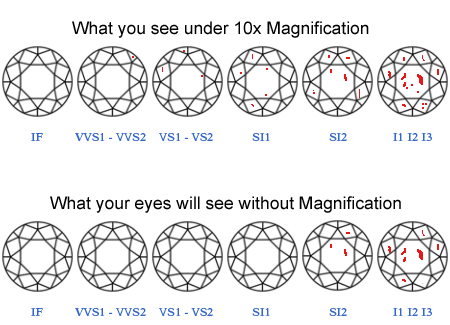
Flawless
Flawless diamond clarity refers to the highest grade of clarity in a diamond. It means that the diamond is free from any internal or external flaws, also known as inclusions and blemishes. These flaws can include tiny crystals, feathers, or other imperfections that can affect the diamond’s appearance and brilliance. In a flawless diamond, even under magnification, no such flaws can be seen. This level of clarity is extremely rare and highly valued in the diamond industry. Flawless diamonds are considered to be the epitome of purity and perfection, making them highly sought after by collectors and connoisseurs alike.
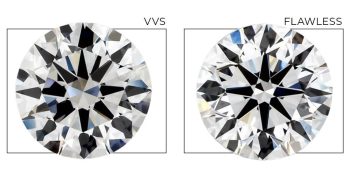
IF
The term “IF” stands for “Internally Flawless,” which means that the diamond has no visible internal inclusions when viewed under 10x magnification. This is the second highest clarity grade a diamond can receive, indicating exceptional clarity and rarity.
It is important to note that while IF diamonds are incredibly rare and valuable, they may still have external blemishes or surface imperfections. These external flaws, however, do not affect the diamond’s clarity grade.
VVS
“VVS” stands for Very Very Slightly Included, which indicates that the diamond has very minimal flaws that are difficult to see even under 10x magnification. These imperfections are typically only visible to trained professionals using specialized equipment.
VS
“VS” stands for Very Slightly Included, which means that the diamond has minor inclusions that are difficult to see under 10x magnification. These inclusions may include tiny crystals, feathers, or clouds within the diamond.
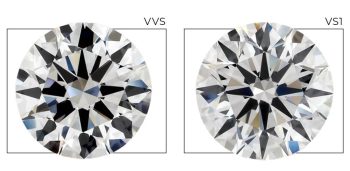
SI
“SI” stands for “Slightly Included”. This means that the diamond has internal characteristics or inclusions that are readily visible under 10x magnification. They may or may not be visible to the eye. These inclusions can include crystals, feathers, or other minerals trapped within the diamond during its formation.
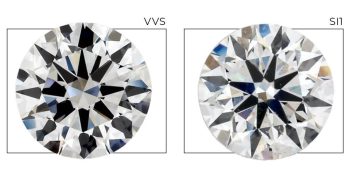
I
I1-I3 are are stones that have “included” imperfections. Almost all of these stones will have eve visible inclusions. These imperfections can include internal characteristics, or external characteristics.
When a diamond is described as having included clarity, it also means that it has imperfections that may affect its overall appearance. Inclusions that are large enough can stop the light from properly refracting. However, it is important to note that included diamonds can still be beautiful and have unique characteristics. It is a matter of personal preference and budget when choosing a diamond with a specific clarity grade.
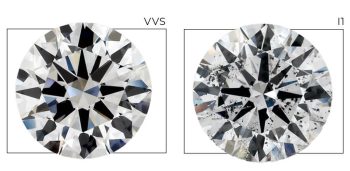
How Diamond Clarity Affects Price
Diamond clarity is a crucial factor that affects the price of a diamond. Clarity refers to the presence of internal or external flaws, known as inclusions and blemishes, respectively. The clarity grade of a diamond is determined by the number, size, and visibility of these imperfections. Diamonds with higher clarity grades have fewer and less visible flaws, making them more valuable and expensive.
Inclusions can range from tiny specks to larger, more noticeable flaws. The size, location, and number of inclusions impact the clarity grade. The fewer and smaller the inclusions, the higher the clarity grade, and subsequently, the higher the price. Diamonds with higher clarity grades are considered more rare and desirable, as they are closer to being flawless.
Blemishes, on the other hand, are external flaws that can include scratches, nicks, or chips on the diamond’s surface. Like inclusions, the size, number, and visibility of blemishes affect the clarity grade. Diamonds with fewer and less visible blemishes command higher prices.
How To Get The Best Bang For Your Buck When Diamond Shopping
When it comes to diamond shopping, getting the best value for your money is essential. Here are some tips to help you make the most informed decision:
- Research is key: Before diving into the world of diamonds, take the time to educate yourself. Learn about the 4Cs – carat weight, cut, color, and clarity – as these factors greatly impact the price and quality of a diamond. Familiarize yourself with reputable diamond grading laboratories and certifications to ensure you are getting an authentic and high-quality diamond.
- Compare prices: Don’t settle for the first diamond you come across. Shop around and compare prices from different jewelers. Online retailers often offer competitive prices, so consider exploring this option as well. Keep in mind that prices can vary significantly based on factors such as the diamond’s size, quality, and the jeweler’s reputation. By comparing prices, you can ensure you are getting the best deal possible.
- Seek expert advice: Don’t hesitate to seek guidance from diamond experts or trusted jewelers. They can provide valuable insights and help you navigate through the vast selection of diamonds available. A knowledgeable professional can assist you in finding a diamond that meets your budget and preferences while ensuring its quality and value.
Other Tips
- Look at the lower of the grades for each level such as VS2 or VV2. Many times the stones are too similar to justify the price jump to go to VS1 or VVS1.
- Go right under a “magic number”. A .97 carat stone with the exact same specs as a 1.0 carat will cost less. Same with a 1.47 carat vs a 1.5.
- Look for a used engagement ring. You can get your center stone at a fraction of the cost from a used ring. Just make sure it is certified.
The Bottom Line
What Is A VVS Diamond should be a question you can answer after reading this post. And e hope we gave you a little more info as well. We create custom jewelry, so whether you bring us a stone or have us source one, we can create whatever you need.
